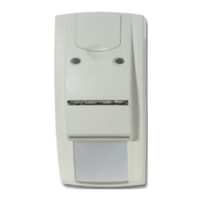- 5 -
PREFERRED SETTINGS
To prevent Anti Mask alarms during Armed state (Night mode), the
following settings are preferred:
Switch 1 "ON”
Switch 3 "OFF"
Switch 4 "OFF"
Switch 5 "OFF"
With these settings the Anti Mask alarms are signaled to the control panel only
during Day by the Trouble relay. The LED’s are controlled by the Latch and
Walk testinput. Resetting of the Anti Masking alarm can only be done in Walk
test mode.
Never show the detector state via the LED’s to intruders.
LED INDICATIONS are controlled by DIP switch 5.
3 If DIP switch 5 is "ON" then the following indications are shown at all times.
3 If DIP switch 5 is "OFF" then the following indications are only shown when
the system is disarmed and the Walk Test line is enabled.
Detector Yellow Red Comment = light
status LED LED = flash
Power on Blinks for 20 sec.
Alarm ---- For alarm period - nominally 3 sec.
AM ---- Until Anti Masking reset.
PIR Trouble ---- Flashes slowly until reset.
AM Trouble ---- Flashes quickly until reset.
Low Battery ---- Always ON until correct voltage restored.
Latch alarm ---- Flashing until reset.
(not displayed during Walk test).
RESET CONDITION
Detector status Condition for reset
PIR Alarm Normally after 3 sec.
PIR Latched alarm Next change from "disarm" to "arm".
AM (auto - reset) Next successful PIR alarm after a 40 sec.
inhibit period.
AM (authorized reset) Next successful PIR alarm in "disarm" and
"walk test" mode.
PIR Trouble Next successful PIR alarm.
Next successful automatic test (every 10 minutes
during "disarm").
AM Trouble Next successful Anti Masking detection.
Next successful automatic test (every 10 minutes
during "disarm").
SELECTING THE COVERAGE PATTERN (Fig. 9-22)
Change the coverage pattern to fit specific requirements by using the mirror
blinders as shown (Figs. 10-15 / Figs.17-22). It is recommended to blind unused
curtains, which might otherwise be looking at walls or windows close to the
detector.
For example:
See Fig. 10 for the mirror curtain coverage pattern corresponding to curtain
2A & 2B, 7A and 9B masked.
Removing label(s) can damage the mirrorsurface!
Note: The range of the detector can, under optimal conditions, be up to 100%
higher as stated.
WINDOW MASK (Fig. 3)
Off factory the window blinder is fitted to the inside of the window of the detec-
tor as shown in Fig. 3. This blinder prevents the detector looking directly at
objects in close proximity (within 1.5 m) and at those directly under the detec-
tor. By partly masking the curtains in this way, the detector will be more stable
during normal use. When undercrawl detection is required, the blinder should
be removed.
Technical
data:
Limited Input Power -
source
Peak to peak ripple
Current consumption
Normal operation
Alarm
Current consumption
Normal operation
Alarm
Mounting height
Target speed range
Microwave frequency
Maximum microwave
output power at 1.0 m.
(Continously)
Alarm output
Tamper output
Trouble Output
Alarm time
Temperature limit
Relative humidity
Size
Weight
Mirror type
Number of zones
View angle
Housing meets
(with sealed cable entry)
Dual loop
NO restriction of use
NOT to be used in:
France, Ireland and
United Kingdom
DD477AMC
DD478AMC
9-15 V (12 Vnom.) -
max. 8 A fuse
2 V (at 12 V )
DD477AMC
13 mA nom.
16 mA max.
DD478AMC
14 mA nom.
17 mA max.
min. 1.8 - max. 3.0 m
min. 0.1 - max. 4.0 m/s
2450 MHz
Enable: 0.005 µW/cm
2
Disable: 0 µW/cm
2
80 mA at 30 V max.
80 mA at 30 V max.
80 mA at 30 V max.
3.0 sec.
-10 °C to +55 °C
max. 95 %
140 x 78 x 68 mm
205 g
9C90D75
9 at 16.0 m
86 °
IP30 IK02
DD477AMC only
DD477AMC, DD478AMC
DD477AM, DD478AM,
DD497AMC
DD498AMC
9-15 V (12 Vnom.) -
max. 8 A fuse
2 V (at 12 V )
DD497AMC
13 mA nom.
16 mA max.
DD498AMC
14 mA nom.
17 mA max.
min. 1.8 - max. 3.0 m
min. 0.1 - max. 4.0 m/s
2450 MHz
Enable: 0.005 µW/cm
2
Disable: 0 µW/cm
2
80 mA at 30 V max.
80 mA at 30 V max.
80 mA at 30 V max.
3.0 sec.
-10 °C to +55 °C
max. 95 %
140 x 78 x 68 mm
205g
7C60D75
7 at 20.0 m
60 °
IP30 IK02
DD497AMC only
DD497AMC, DD498AMC
DD497AM, DD498AM

